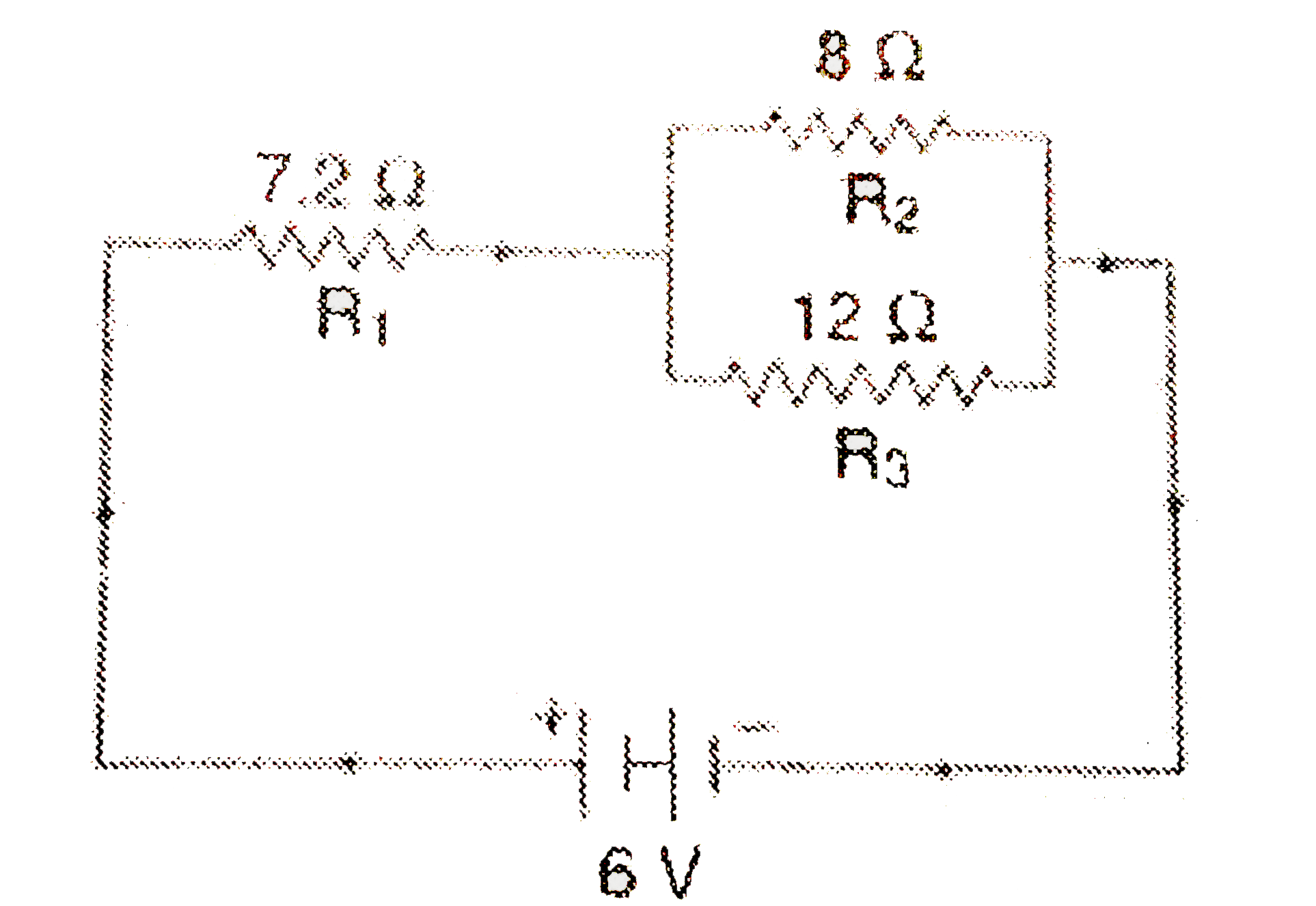Two conductors A and B of resistances 5 Ω and 10 Ω respectively are first joined in parallel and then in series. In each case the voltage applied is 20 V.
(i) Draw the circuit diagram to show the combination of these conducton in each case.
(ii) In which combination will the voltage across the conductors A and B be the same ?
(iii) In which arrangement will the current through A and B be the same ?
(iv) Calculate the equivalent resistance for each arrangement.Solution in Kannada
(i)  <span class=) <br><imgsrc=hps:/d10lpgp6xz60nq.cloudont.≠tphysicsima≥sOSWQBSCIX_C12E02111_S02##)
<br><imgsrc=hps:/d10lpgp6xz60nq.cloudont.≠tphysicsima≥sOSWQBSCIX_C12E02111_S02##)
(ii) Voltage across A and B will be same in parallel arrangement.
(iii) Current in A and B will be same in series arrangement.
(iv) Equivalent resistance in
(a) Parallel combination Rp
=R1R2R1+R2=5×105+10=103
=3.33 W
(b) Series combination Rs=R1+R2
= 5+10
= 15 W
Topper's Solved these Questions
- ELECTRICITYBOOK - OSWAAL PUBLICATIONCHAPTER - ELECTRICITYEXERCISE - NCERT CORNER ( Intext Questions )
23 Videos
- ELECTRICITYBOOK - OSWAAL PUBLICATIONCHAPTER - ELECTRICITYEXERCISE - Textbook Exercises
22 Videos
- ELECTRICITYBOOK - OSWAAL PUBLICATIONCHAPTER - ELECTRICITYEXERCISE - TOPIC-2 ( Short Answer Type Questions -II )
53 Videos
- LIGHT-REFLECTION AND REFRACTIONBOOK - OSWAAL PUBLICATIONCHAPTER - LIGHT-REFLECTION AND REFRACTIONEXERCISE - NCERT CORNER (TEXTBOOK EXERCISES)
15 Videos
Similar Questions
What does an electric circuit mean ?
View SolutionA piece of wire of resistance R is cut into five equal parts. These parts are then connected in parallel. If the equivalent resistance of this combination is R' then the ratio R/R' is -
View SolutionWhy are coils of electric toasters and electric irons are made of an alloy rather than a pure metal?
View SolutionWhich one of the following materials cannot be used ot make a lens?
View SolutionDraw a circuit diagram of an electric circuit containing a cell, a key, an ammeter, a resistance of 2Ω in series with a combination of two resistors (4Ω each) in parallel and a voltmeter across the parallel combination. Will the potential difference across the 2Ω resistor be the same as that across the parallel combination of 4Ω resistors ? Give reason.
View Solution(a) what is meant by series and parallel combination of resistances ?
(b) in which case, series combination or parallel combination, the combined resistance is less than any of the individual resistances ?
(c ) How should two resistance of 2Ω each be connected so as to produce an equivalent resistance of 1Ω ?
In the circuit diagram given here , find:
(i) total resistance of the circuit
(ii) total current flowing in the circuit, and
(iii) the potential difference across R1

View SolutionThe series combination of two batteries, both of the same emf 10 V, but different internal resistance of 10Ω and 5Ω is connected to the parallel combination of two resistors 30Ω and RΩ . The voltage difference across the battery of internal resistance 10Ω is zero, the value of R (in Ω ) is : _________.
View SolutionResistances of two coils of wire are 3Ωand6Ω. If these coils be connected is (i) series and in (ii) parallel combination, then what will be the equivalent resistance in each case ?
View SolutionTwo conductors A and B of resistances 5Ωand10Ω respectively are first joined in parallel and then in series. In each case the voltage applied is 20V.
(a) Draw the circuit diagram to show the combination of these conductors in each case.
(b) In which combination will the voltage across the conductors A and B be the same?
(c ) In which arrangement will the current through A and B is the same?
(d) Calculate the equivalent resistance for each arrangement.
View SolutionTwo resistors X and Y of resistances 2 ω and 3 ω respectively are first joined in parallel and then in series. In each case the voltage supplied is 5 V.
(i) Draw circuit diagrams to show the combination of resistors in each case.
(ii) Calculate the voltage across the 3 Q resistor in the series combination of resistors.
View SolutionDraw a circuit diagram of an electric circuit containing a cell, a key, an ammeter, a resistance of 2Ω in series with a combination of two resistors (4Ω each) in parallel and a voltmeter across the parallel combination. Will the potential difference across the 2Ω resistor be the same as that across the parallel combination of 4Ω resistors ? Give reason.
View SolutionAn a.c. voltage V=Vm sin ωt is applied across a
(i) series RC circuit in which the capacitive impedance is 'a' times the resistance in the circuit,
(ii) series RL circuit in which the inductive impedance is 'b' times the resistance in the circuit. Calculate the value of the power factor of the circuit in each case.
View SolutionIn an a.c. circuit the voltage across an inductance and resistance, joined in series, are 120 V and 160 V respectively. The total voltage applied across the combined circuit is …………..
View SolutionThe series combination of two batteries, both of the same emf 10 V, but different internal resistance of 10Ω and 5Ω is connected to the parallel combination of two resistors 30Ω and RΩ . The voltage difference across the battery of internal resistance 10Ω is zero, the value of R (in Ω ) is : _________.
View SolutionConsider a series combination of two resistors of resistances 10 Omega and 40 Omega across which a potential difference of 5 V is applied. Find the current in the circuit and the potential difference across each resistor.
View Solution
